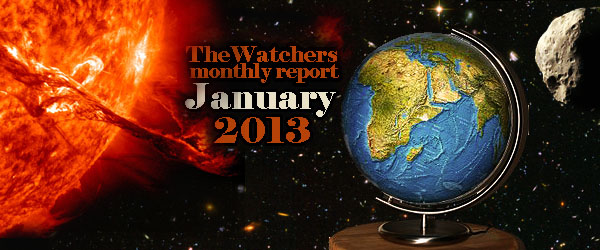The Watchers - 2/06/13, By Chillymanjaro

In January we saw some increased seismic activity worldwide. The strongest earthquake was registered as M 7.5 and it hit Southeastern Alaska on January 5, 2013. M 6.8 hit Atacama region in Chile on January 30, 2013. Sharp increase in seismic activity was recorded around Santa Cruz Islands, Solomon Islands in last week of January. Swarm of M5+ and M6+ earthquakes struck the area. Ending with January 31, worldwide seismographs recorded 72 M5+, 6 M6+ and one M7+ earthquakes.
We saw landslides triggered by earthquake activity and impacts of tropical cyclones. Also, impressive rockfall happened in New Zealand, when massive part of Mt. Dixon collapsed.
44 volcanoes erupted in January. Increased activity was recorded around Stromboli, Etna, Tungurahua, Reventador, White Island, Paluweh, Colima, Copahue, Manam and all Kamchatkan volcanoes. Submarine volcano near El Hierro at Canary Islands show some seismic activity at the beginning of the month.
January is the month of Pacific Tropical Storm season. We saw nine named storm systems, generally impacting Australia, Madagascar and areas around Philippines. Remnants of Tropical Cyclone Oswald caused devastated record floods in Australia. Massive floods also ravaged areas around Limpopo river in Mozambique.
January was month of extreme temperature records. Massive heatwave backed up by devastating wildfires hit Australia and Tasmania, with maximum recorded temperatures reaching almost 50 degrees Celsius. At the same time cold snap was stretching across Europe, Asia and North America bringing heavy snowfall and record low temperatures.
Sudden stratospheric warming phenomenon caused an Arctic outbreak in North America during the mid-January. The polar vortex splitted and shifted its position to northern Quebec, Canada. The other piece of the vortex was displaced southward setting up a wedge of cold air over Europe and Asia, displacing steering-levels winds and setting up cold storms from the UK to part of the Middle East. Beginning of 2013 started with intense cold and freezing temperatures in western and northeastern China, Mongolia, Russia, and the Korean Peninsula as well as in Middle East and parts of Europe.
Dust storms blew through all month. Tons of dust particles was uplifted into atmosphere. Probably the most impressive dust storm was the one in Australia that blanketed the city of Onslow in the first half of the month. Smoke and haze were covering Indian subcontinent, as well as central Africa. Some parts of Northern Hemisphere reached record air pollution levels. The worst situation was in Beijing, China.
Our planet was at perihelion, the point in its orbit at which it is closest to the Sun. During this perihelion, the Earth was exactly 147,098,161 kilometers (91,402,560 miles) from the Sun.
Solar activity was at low to moderate levels. At the beginning of the month, visible solar disk was peppered with sunspots. At one period there were 14 numbered sunspots. The biggest of them, AR 1654 stretched more than 180,000 km (14 Earth diameters) from end to end. There were only 5 M-class events, however, we saw coronal mass ejections mostly emanating from solar prominences. There were only few geomagnetic disturbances.
Quadrantid meteor shower had nice show at the beginning of the month and few interesting asteroid/comet flybys (Apophis, Linear) were making warm-up for February which is expected to bring us some impressive skywatching events.
At the Mars, Curiosity found widespread evidence for flowing water in the highly diverse, rocky scenery of Yellowknife Bay area on Mars and it conducted first martian ground drill ever. And back here, at Earth, scientists successfully drilled into Lake Whillans, a subglacial expanse of water measuring about 1.2 square miles (3 square kilometers) and hidden deep beneath the Antarctic ice sheet.
Kepler mission scientists announced on January 7th the discovery of literally hundreds of new exoplanet candidates — 461, to be exact — orbiting distant stars within a relatively small cross-section of our galaxy, bringing the total number of potential planets awaiting confirmation to 2,740.
This was in short. There were lot’s of amazing and interesting events and discoveries we experienced in January. Bellow is a full list, day by day. Enjoy!
To read the rest of this story, visit The Watchers.

